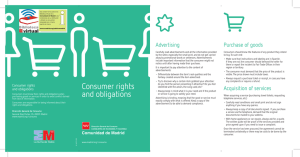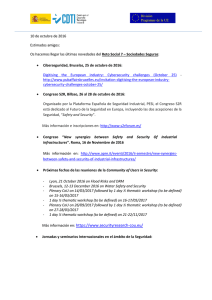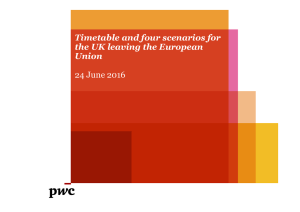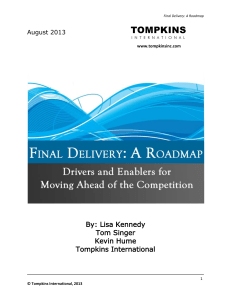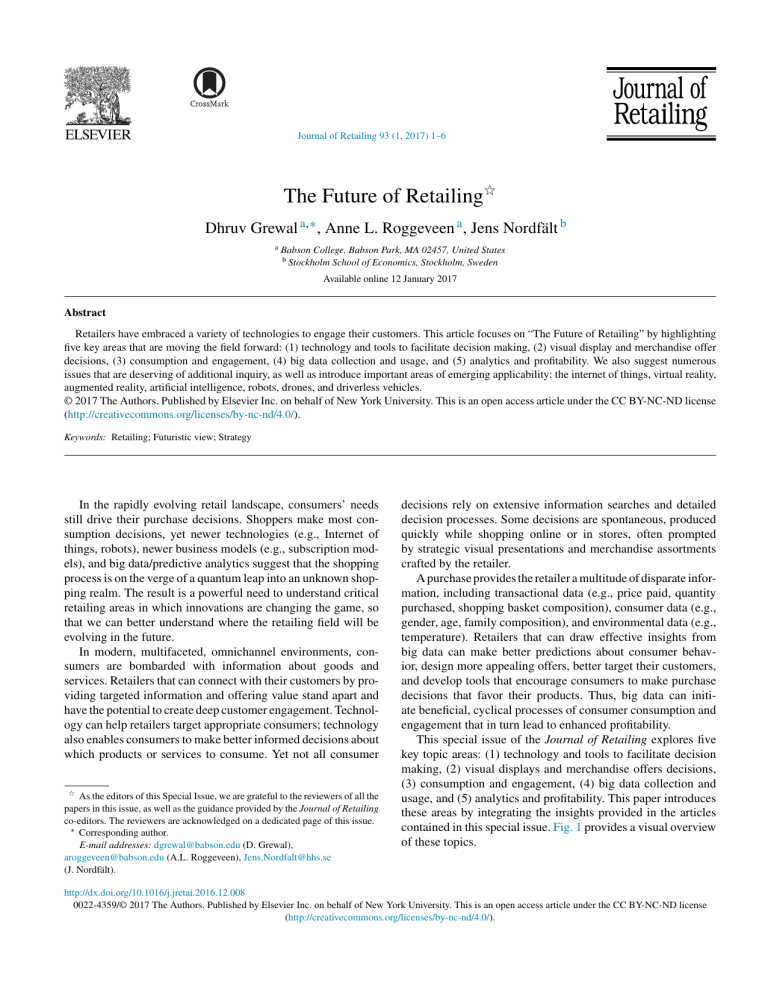
Journal of Retailing 93 (1, 2017) 1–6 The Future of Retailing夽 Dhruv Grewal a,∗ , Anne L. Roggeveen a , Jens Nordfält b a Babson College, Babson Park, MA 02457, United States b Stockholm School of Economics, Stockholm, Sweden Available online 12 January 2017 Abstract Retailers have embraced a variety of technologies to engage their customers. This article focuses on “The Future of Retailing” by highlighting five key areas that are moving the field forward: (1) technology and tools to facilitate decision making, (2) visual display and merchandise offer decisions, (3) consumption and engagement, (4) big data collection and usage, and (5) analytics and profitability. We also suggest numerous issues that are deserving of additional inquiry, as well as introduce important areas of emerging applicability: the internet of things, virtual reality, augmented reality, artificial intelligence, robots, drones, and driverless vehicles. © 2017 The Authors. Published by Elsevier Inc. on behalf of New York University. This is an open access article under the CC BY-NC-ND license (http://creativecommons.org/licenses/by-nc-nd/4.0/). Keywords: Retailing; Futuristic view; Strategy In the rapidly evolving retail landscape, consumers’ needs still drive their purchase decisions. Shoppers make most consumption decisions, yet newer technologies (e.g., Internet of things, robots), newer business models (e.g., subscription models), and big data/predictive analytics suggest that the shopping process is on the verge of a quantum leap into an unknown shopping realm. The result is a powerful need to understand critical retailing areas in which innovations are changing the game, so that we can better understand where the retailing field will be evolving in the future. In modern, multifaceted, omnichannel environments, consumers are bombarded with information about goods and services. Retailers that can connect with their customers by providing targeted information and offering value stand apart and have the potential to create deep customer engagement. Technology can help retailers target appropriate consumers; technology also enables consumers to make better informed decisions about which products or services to consume. Yet not all consumer 夽 As the editors of this Special Issue, we are grateful to the reviewers of all the papers in this issue, as well as the guidance provided by the Journal of Retailing co-editors. The reviewers are acknowledged on a dedicated page of this issue. ∗ Corresponding author. E-mail addresses: [email protected] (D. Grewal), [email protected] (A.L. Roggeveen), [email protected] (J. Nordfält). decisions rely on extensive information searches and detailed decision processes. Some decisions are spontaneous, produced quickly while shopping online or in stores, often prompted by strategic visual presentations and merchandise assortments crafted by the retailer. A purchase provides the retailer a multitude of disparate information, including transactional data (e.g., price paid, quantity purchased, shopping basket composition), consumer data (e.g., gender, age, family composition), and environmental data (e.g., temperature). Retailers that can draw effective insights from big data can make better predictions about consumer behavior, design more appealing offers, better target their customers, and develop tools that encourage consumers to make purchase decisions that favor their products. Thus, big data can initiate beneficial, cyclical processes of consumer consumption and engagement that in turn lead to enhanced profitability. This special issue of the Journal of Retailing explores five key topic areas: (1) technology and tools to facilitate decision making, (2) visual displays and merchandise offers decisions, (3) consumption and engagement, (4) big data collection and usage, and (5) analytics and profitability. This paper introduces these areas by integrating the insights provided in the articles contained in this special issue. Fig. 1 provides a visual overview of these topics. http://dx.doi.org/10.1016/j.jretai.2016.12.008 0022-4359/© 2017 The Authors. Published by Elsevier Inc. on behalf of New York University. This is an open access article under the CC BY-NC-ND license (http://creativecommons.org/licenses/by-nc-nd/4.0/). 2 D. Grewal et al. / Journal of Retailing 93 (1, 2017) 1–6 Fig. 1. Organizing framework. Technology & Tools to Facilitate Decision Making Technological change continues to be a game changer for retailing that can simultaneously benefit consumers and retailers. For example, technology enables consumers to make more informed decisions, receive more targeted and beneficial offers, and obtain faster service. It also assists retailers in reaching appropriate consumers at lower costs, due to technologically created efficiencies. Inman and Nikolova (2017) draw attention to how technologies can benefit both consumers and businesses, which ultimately enhance the businesses’ profitability. They highlight mobile apps, scan-and-go technologies, self-checkouts, QueVision, and smart shelf technology. For example, self-check-out technology helps shoppers scan, bag, and pay for products without any need to interact with a cashier. Customers thus gain control; retailers enjoy reduced labor costs from the fewer number of cashiers required. QueVision gives retailers insights into how many registers are needed and the expected wait times, using data garnered from infrared sensors over store doors and cash registers, predictive analytics, and real-time data feeds from point-of-sale systems. Using this technology, grocery retailers have been able to reduced wait times from more than 4 min to less than 30 s. Thus, QueVision improves the customer experience, through shorter wait times, and benefits the firm in the form of happier, less stressed employees. The introduction of smartphones have revolutionized shopping. From mobile apps, to geo-fenced targeted offers, to constant access to the online environment, the advances in this realm have led to constantly changing consumer expectations and to retailers’ enhanced ability to connect with consumers. Scan-and-go technologies allow customers to use their smartphones to scan items as they shop, then use the retailer’s app to pay. Amazon is pushing this innovation even further, removing the need for consumers to scan items, through their Amazon Go technology. Amazon Go allows customers to scan their smartphone as they enter the store, pick up the products they want, and leave. Computer vision, sensor fusion, and deep learning technologies automatically detect when products are taken from or returned to shelves and keep track of items in a virtual cart. After consumers leave the store, they are charged and sent an automatic receipt. All customers need is a smartphone, an Amazon account, and the Amazon Go app (Amazon 2016). These new technologies are revolutionizing the consumer shopping experience and will set new expectations of what shopping can or should be in the future. Mobile technology also allows retailers to offer relevant offers that reflect locational information (e.g., time of day, weather, location), using location-based applications (e.g., Google maps) (Grewal et al. 2016). For example, feel-good products can be promoted effectively when the weather is bad (Rosman 2013). Similarly, mobile promotions can take advantage of indoor positioning information gathered using iBeacons in order to offer location relevant promotions. Personalizing technologies to make them user specific clearly has benefits for both consumers and retailers. However, a personalization–privacy paradox warrants consideration. Personalizing information for customers can both enhance and diminish consumer engagement with the firm, because consumers may recognize how much data and information retailers have about them and begin worry about their privacy. Retailers therefore need to be careful to use their knowledge about customers in a way that balances out this personalization–privacy paradox (Aguirre et al. 2015). We question whether these new technologies will affect all types of retailing and all types of shoppers in the same way. Retailers use their apps to deliver a variety of promotions; perhaps these apps would be especially useful for retailers that adopt high–low pricing strategies or discount retailers. Alternatively, perhaps retailer apps are primarily good for reaching deal-prone customers. Another consideration pertains to the store, such that small stores could serve as delivery/pick-up points for online retailers, or they might focus more on meeting shoppers’ social needs (Magi 2003), in that social shoppers are overrepresented in smaller store formats. Visual Display & Merchandise Offer Decisions Today’s consumers are bombarded with merchandise and offers. The question is how to design and deliver offers that stand out. Understanding this can help retailers decide how, when, and where to display merchandise (and associated offers), according to the channel format (in store or online). Manufacturers also recognize the importance of ensuring that consumers pay attention to their merchandise and offers, such that they seek ways to make their merchandise stand out from the competition on the shelf or online. Kahn (2017) highlights the need for manufacturers and retailers to account for a “visual salience bias” and make assortments easier for consumers to process. She recommends several key strategies for doing so, such as reducing the size of the assortment presented, reducing information intensity, making sure D. Grewal et al. / Journal of Retailing 93 (1, 2017) 1–6 each item relates to the assortment context, and carefully thinking through the spatial positioning of merchandise. Further evidence on the role of spatial orientation of merchandise presentation is provided by Nordfält et al. (2014). They examine the importance of the vertical, horizontal, and diagonal orientation of merchandise. Their results demonstrate the superiority of a vertical organization of merchandise (e.g., vertical arrays of multiple beverages in a cold case result in more purchases than the same beverages in a horizontal display). Vertical displays of towels, versus a diagonal display, resulted in a more than 90% increase in product pick-ups by customers. In addition to their organization on the shelf, on the display, or on the website, product packages are an important aspect of the visual scenery. Kahn (2017) highlights the importance of various visual components, such as where an image appears on a product package and the shape of that package. Investigations of packaging typically take a shape or design perspective, but Krishna, Cian, and Aydinoglu (2017) propose extending this view to determine how the different layers of a package might affect consumer shopping engagement. The packaging and product thus consists of three hierarchical levels: the inner core, which is the product itself (e.g., pill, piece of chocolate); an intermediate level that consists of the container (e.g., bottle for pills, wrapper that holds chocolate); and an outer layer, which is what is immediately evident to consumers prior to their purchase (e.g., carton that contains the bottle that contains the pill; fancy box that holds all the chocolates). These authors cite the importance of understanding the roles of these three different layers, across both a physicality dimension and a functional dimension. That is, packaging levels exert a significant influence on consumers’ sensory experiences. Certain packages facilitate consumers’ ability to examine the product visually or physically, such as clear packaging that allows customers to engage visually with a product. Packages that do not cover the entire product also enable customers to feel the texture of the materials. Thus, package types can have significant influences on how consumers consciously and subconsciously engage with products. Packaging also might affect consumers’ perceptions and consumption decisions. A package can set consumer expectations about the amount of product; for example, a perfume may take up only ten percent of the outer package, and the intermediate glass bottle would account for 40% of the outer box. In this high-end category, the smaller volume drives scarcity expectations, associated with these luxury, high priced products. Visual and spatial components of the packaging, in conjunction with other sensory dimensions (Spence et al. 2014), thus establish customers’ expectations and their consumption experience. As part of their visual merchandising efforts, retailers must consider locational effects for their merchandise and their sales promotions, both online and in stores. Recent research demonstrates that the location of the sale price in displays and communications online can have considerable impacts. For example, Biswas et al. (2013) reveal that the sale price is more effective when it is to the right of a higher advertised reference price rather than placed to the left. Suri et al. (2017) similarly find that when the price is portrayed to the right of the package, it is more effective for increasing purchase intentions and 3 purchases of lower involvement products (e.g., beverages) than when it is on the left. Consumption & Engagement Consumers’ actual consumption of goods and services is at the heart of all retailing. Designing goods that offer value to consumers is critical to success of retailers and service providers. Creating a superior customer experience can differentiate companies (Grewal, Levy, and Kumar 2009; Verhoef et al. 2009). This holistic customer experience concept “involves the customer’s cognitive, affective, emotional, social and physical responses to the retailer. This experience is created not only by those elements which the retailer can control (e.g., service interface, retail atmosphere, assortment, price), but also by elements that are outside of the retailer’s control (e.g., influence of others, purpose of shopping)” (Verhoef et al. 2009, p. 32). Firms already acknowledge the importance of understanding and managing customer experience and engagement levels (Accenture 2015; Marketing Science Institute 2016), as do academics (e.g., Grewal, Levy, and Kumar 2009; Lemon and Vehoef 2016; Puccinelli et al. 2009; Verhoef et al. 2009). However, no in-depth research has probed ways to enhance customers’ sense of engagement. Grewal et al. (2017) present a hierarchal model of customer engagement that suggests that incorporating consciousness may facilitate such enhancements. To develop this model, Grewal et al. (2017) draw on research into conscious capitalism (Mackey and Sisodia 2014) as the grounding principles. These principles include incorporating a higher purpose and values to center the mission of the company; having strong leadership that imbues the corporate culture with a team-oriented approach to fulfilling the company’s purpose and values; and striving for an integrative stakeholder orientation. Building on those foundations, Grewal et al. (2017) argue that for a hierarchical, three-level approach to enhancing customer engagement that reflects the customer experience, an emotional connection, and a shared identity. Conscious retailers thus create deeper emotional connections with customers by leveraging their purposes and values. At the highest levels of engagement, customers even come to identify with the retailer. Another way for retailers to improve a customer experience that leads to greater engagement is by leveraging social media. Roggeveen and Grewal (2016) suggest that five effects drive consumers to engage with social media: connected, network, information, dynamic, and timeliness effects. The connected effect is based on the innate need that people have to connect with others; social media has changed the format of these relationships. The network effect refers to an ability to relate to and broadcast information to others. Yet, another driver of social media engagement is convenience or timeliness. Consumers can constantly access information, due to the ubiquitous presence of smartphones and tablets and their dedicated apps. Apps then produce another driver of social media engagement for retailers, namely, the ability to provide relevant information and participate in dynamic conversations with customers. These information and dynamic effect factors also enhance consumers’ desire to engage with 4 D. Grewal et al. / Journal of Retailing 93 (1, 2017) 1–6 their extended social network. Understanding how these various spokes turn the wheel of social media engagement is another way that retailers can enhance their engagement with consumers. Of course, the consumer experience also depends on the retailer’s category. For example, food retailers may engage with customers to promote healthier eating. Wansink (2017) provides a useful, important retail intervention framework that highlights three major components for enhancing customer engagement in the domain of food retailing: the role of signage, the structure of the store/merchandise placement, and the service provided by employees or electronic aids. All three components influence which merchandise is most convenient to purchase, attractive, and viewed as more normative. Wansink (2017) also suggests innovative tools and techniques for leveraging signage and service components to make healthier products more convenient, accessible, and normative to purchase. In a sense, increasing engagement with healthier products ultimately results in healthier consumers. Similarly, retailers must consider how to best engage customers online or in stores using visual cues contained within digital displays (Roggeveen, Nordfält, and Grewal 2016) or dynamic messages (Roggeveen et al. 2015). Dynamic messages (e.g., videos), as opposed to static ones (e.g., pictures), help mentally transport customers into the experience, which creates a stronger emotional connection, which in turn reduces customers’ price sensitivity and enhances their consumption of more hedonic options (Roggeveen et al. 2015). Substantial existing research focuses on the customer experience already (e.g., Grewal, Levy, and Kumar 2009; Lemon and Vehoef 2016; Puccinelli et al. 2009; Verhoef et al. 2009). Future research should focus on employee engagement. For retailers, employee engagement could result in greater consumer engagement. Verhoef et al. (2009) highlight the need to understand the role of dynamic experiences and how experiences and engagement levels evolve over time. Big Data Collection & Usage Retailers have always been inundated with data. In the recent years, they increasingly have started to take advantage of options for organizing these data better, improved access to computing power, and the availability of proprietary or enterprise analytical systems. The power of big data, coupled with effective analytical systems, permits retailers to manage a host of issues. Bradlow et al. (2017) organize the various sources of retail data, including those captured from enterprise systems; customer/household information captured from loyalty, website, or social data; and locational-based details gathered using mobile and apps. These authors discuss the dimensions of big data in terms of the customer, product, location, time, and channel, highlighting how retailers can use these data strategically to optimize prices and maximize sales. Thus, big data are helping retailers and researchers understand customer behavior. Their emergence has led researchers to undertake field studies and experiments that provide clearer assessments of the causality between an exogenous or independent variable (e.g., promoted price, display location, assortment expansions, service responses) and a host of dependent variables, from increased store sales and profitability to brand switching. Retailers can rely on survey-based measures, such as purchase intentions or positive evaluations, to generate greater engagement, loyalty, and profits. Analytics & Profitability Kumar, Anand, and Song (2017) highlight the importance of carefully developed, thought-through retail strategies supplemented with analytics. They also link these strategies to retail profitability. Such strategies can be explicated at four levels: market, firm, store, and customer. For example, at the store level, these authors highlight what we know about strategies associated with marketing mix location and atmospherics, and then specify topics that need further exploration. In addition, they lay out actions that need to be undertaken to execute these strategies. As an illustration, at the store level, key executional actions include personalized pricing, dynamic pricing, mobile targeting, and technology to improve customer experiences. In addition, retailers should carefully develop and manage their vendor relationships. Ailawadi and Farris (2017) highlight important issues that retailers wrestle with as they move toward and manage multi- and omnichannel distribution operations. There are clear benefits to an omnichannel distributional structure from a consumer’s point of view, ranging from transparency to uniform policies. However, for retailers and suppliers, such forms of distribution pose unique challenges. To understand the challenges and the important questions they raise, Ailawadi and Farris (2017) specify some key insights from academic research as it pertains to the focal metrics being used in practice, in terms of the depth and breadth of distribution. The Further Future of Retailing Retail is evolving at an accelerated rate due to changes made possible by technologies and evolving consumer behaviors. Integrating channels and the power of big data are not distinctive factors anymore but rather are prerequisites of competitiveness. Where the field goes will depend on even newer emerging forces: The Internet of things, virtual or augmented reality, artificial intelligence, and robots/drones/driverless vehicles (Deloitte 2016). Research into the Internet of things should clarify how it may influence shopping behavior, as well as the role of frontline employees (Rafaeli et al. 2017). Smart homes are being designed with a host of smart appliances (e.g., refrigerators) that can reorder products as stocks get low. Similarly, smart cars convey relevant information to service departments and may schedule future service appointments. Thus, research needs to explore whether the Internet of things will increase consumers’ engagement with retailers, service providers, and brands or if it will reduce consumer engagement, as machines take over all the “talking” to other machines (i.e., the start of machine-to-machine commerce). Virtual and augmented reality has offered vast promise for a long time; those promises are just beginning to be realized. The D. Grewal et al. / Journal of Retailing 93 (1, 2017) 1–6 new forms of technology-based reality and applications enhance sensory perceptions (Poncin and Mimoun 2014). For example, fashion retailers use new technology to help customers engage in virtual fashion shows (Deloitte 2016). Apps using augmented reality also are advancing the reality, such as apps for car dealers that allow consumers to view how different components look on a car, or games such as Pokémon GO that combine a hunt for virtual creatures (Pokémon) with the real-world locations of the players. A mobile device’s GPS capability makes this possible. Apps that rely on artificial intelligence (AI) also are on the rise in a variety of contexts, from Siri on the Apple phone, to Cortana on Microsoft, to Alexa on Amazon’s Echo, to query-based response AI systems for retailers (e.g., Macy’s On Call). These AI-based responses can have tremendous positive impact on customers as they shop, whether physically or online. They can gather information about where products are physically located within a store, answer questions about the functionalities of a product, and make suggestions about what other products might work well in combination with the purchased item. The answers also may be tailored, according to the consumer’s knowledge (e.g., accessing historical customer data sets and using predictive analytics to recommend relevant information or products). The consequences could include more informed and engaged customers, but they also might mean that service employees’ jobs would need to be retooled to enable them to provide information at an even higher level than available in an AI application. Building on AI-based technology, many companies are testing driverless vehicles, and various manufacturers and retailers are taking advantage of advances in the technology for robotics and drones (Van Doorn et al. 2017). Major manufacturers and retailers already use robots extensively in their distribution centers. Amazon also has publicly discussed its plans for drone delivery, to augment its existing delivery options. Such applications suggest a host of research possibilities, such that studies should pursue a better understanding of the short- and long-term benefits and consequences of different delivery methods. In conclusion, newer forces will influence how shoppers select channels, choose products and services, and make purchases. The worlds of online and offline are converging. Knowing what is different and what is similar in these two worlds, as well as how new technologies are going to impact both, is key for the future of retailing. Innovations are likely to help customers make good decisions, feel less time pressure, or even increase their confidence and satisfaction with their decisions. Retailers in turn need to embrace these new and emerging technologies to make their customers even more engaged, while also making their lives simpler. Finding ways to do so remains an important area of inquiry, worthy of continued exploration. References Accenture (2015). “Improving Customer Experience Is Top Business Priority for Companies Pursuing Digital Transformation, According to Accenture Study,” news release, (October 27), https://newsroom.accenture.com/news/ improvingcustomer-experience-is-top-business-priority-forcompaniespursuing-digital-transformation-according-to-accenturestudy.htm. 5 Aguirre, Elizabeth M., Dominik Mahr, Dhruv Grewal, Ko de Ruyter and Martin Wetzels (2015), “Unraveling the Personalization Paradox: The Effect of Information Collection and Trust-Building Strategies on Online Advertisement Effectiveness,” Journal of Retailing, 91 (1), 34–49. Ailawadi, Kusm L. and Paul W. Farris (2017), “Managing Multi- and Omni-Channel Distribution: Metrics and Research Directions,” Journal of Retailing, 93, 121–36. Amazon (2016), Amazon Go: Frequently Asked Questions, (accessed December 12, 2016), [https://www.amazon.com/b?node=16008589011] Biswas, Abhijit, Sandeep Bhowmick, Abhijit Guha and Dhruv Grewal (2013), “Consumer Evaluation of Sale Price: Role of the Subtraction Principle,” Journal of Marketing, 77 (July), 49–66. Bradlow, Eric T., Manish Gangwar, Praveen Kopalle and Sudhir Voleti (2017), “The Role of Big Data and Predictive Analytics in Retailing,” Journal of Retailing, 93, 76–96. Deloitte (2016), Retail Trends in 2016, (accessed December 12, 2016), [https://www2.deloitte.com/uk/en/pages/consumer-business/articles/ retail-trends-2016.html] Grewal, Dhruv, Yakov Bart, Martin Spann and Peter Pal Zubcsek (2016), “Mobile Advertising: A Framework and Research Agenda,” Journal of Interactive Marketing, 34 (May), 3–14. Grewal, Dhruv, Michael Levy and V. Kumar (2009), “Customer Experience Management: An Organizing Framework,” Journal of Retailing, 85 (1), 1–14. Grewal, Dhruv, Anne L. Roggeveen, Raj Sisodia and Jens Nordfält (2017), “Enhancing Customer Engagement Through Consciousness,” Journal of Retailing, 93, 55–64. Inman, J. Jeffrey and Hristina Nikolova (2017), “Shopper-Facing Retail Technology: A Retailer Adoption Decision Framework Incorporating Shopper Attitudes and Privacy Concerns,” Journal of Retailing, 93, 7–28. Kahn, Barbara (2017), “Using Visual Design to Improve Customer Perceptions of Online Assortments,” Journal of Retailing, 93, 29–42. Krishna, Aradhna, Luca Cian and Nilufer Z. Aydinoglu (2017), “Sensory Aspects of Package Design,” Journal of Retailing, 93, 43–54. Kumar, V., Ankit Anand and Hyunseok Song (2017), “Future of Retailer Profitability: An Organizing Framework,” Journal of Retailing, 93, 97–120. Lemon, Katherine N. and Peter C. Vehoef (2016), “Understanding Customer Experience Throughout the Customer Journey,” Journal of Marketing, 80 (6), 69–96. Mackey, John and Rajendra Sisodia (2014), Conscious Capitalism: Liberating the Heroic Spirit of Business, Cambridge, MA: Harvard Business Review Press. Magi, Anne W. (2003), “Share of Wallet in Retailing: The Effects of Customer Satisfaction, Loyalty Cards and Shopper Characteristics,” Journal of Retailing, 79 (Summer), 97–106. Marketing Science Institute (2016), Research Priorities 2016–2018, Cambridge, MA: Marketing Science Institute. http://www.msi.org/uploads/ articles/MSI RP 16-18.pdf Nordfält, Jens, Dhruv Grewal, Anne L. Roggeveen and Krista Hill (2014), “Insights from In-store Marketing Experiments,” In Review of Marketing Research: Shopper Marketing and the Role of In-Store Marketing, Vol. 11, Grewal Dhruv, Roggeveen Anne L. and Nordfält Jens eds. Emerald Books, 127–46. Poncin, Ingrid and Mohamed Slim Ben Mimoun (2014), “The Impact of ‘Eatmospherics’ on Physical Stores,” Journal of Retailing and Consumer Services, 21 (5), 851–9. Puccinelli, Nancy, Ronald C. Goodstein, Dhruv Grewal, Rob Price, Priya Raghubir and David Stewart (2009), “Customer Experience Management in Retailing: Understanding the Buying Process,” Journal of Retailing, 85 (1), 15–30. Rafaeli, Anat, Daniel Altman, Dwayne D. Gremler, Ming-Hui Huang, Dhruv Grewal, Bala Iyer, A. Parasuraman and Ko de Ruyter (2017), “The Future of Frontline Research: A Glimpse through the Eyes of Thought Leaders,” Journal of Service Research,, (forthcoming). Roggeveen, Anne L. and Dhruv Grewal (2016), “Engaging Customers: The Wheel of Social Media Engagement,” Journal of Consumer Marketing, 33 (2) (editorial). 6 D. Grewal et al. / Journal of Retailing 93 (1, 2017) 1–6 Roggeveen, Anne L., Dhruv Grewal, Claudia Townsend and R. Krishnan (2015), “The Impact of Dynamic Presentation Format on Consumer Preferences for Hedonic Products and Services,” Journal of Marketing, 79 (November), 34–49. Roggeveen, Anne L., Jens Nordfält and Dhruv Grewal (2016), “Do Digital Displays Enhance Sales? Role of Retail Format and Message Content,” Journal of Retailing, 92 (March), 122–31. Rosman, Katherine (2013), “Weather Channel Now Also Forecasts What You’ll Buy,” The Wall Street Journal,, (August 14, http://www.wsj.com/) Spence, Charles, Nancy M. Puccinelli, Dhruv Grewal and Anne L. Roggeveen (2014), “Store Atmospherics: A Multisensory Perspective,” Psychology & Marketing, 31 (July), 472–88. Suri, Raj, Anne L. Roggeveen, Nancy M. Puccinelli, and Dhruv Grewal (2017). “Should Prices be Placed in the Left-Visual Field or the Right-Visual Field?” Working Paper. Van Doorn, Jenny, Martin Mende, Stephanie M. Noble, John Hulland, Amy L. Ostrom, Dhruv Grewal and J. Andrew Petersen (2017), “Domo Arigato Mr. Roboto: The Emergence of Automated Social Presence in Customers’ Service Experiences,” Journal of Services Research,, (forthcoming). Verhoef, Peter, Katherine Lemon, A. Parasuraman, Anne Roggeveen, Michael Tsiros and Leonard Schlesinger (2009), “Customer Experience Creation: Determinants, Dynamics and Management Strategies,” Journal of Retailing, 85 (1), 31–41. Wansink, Brian (2017), “Healthy Profits: An Interdisciplinary Retail Framework that Increases the Sales of Healthy Foods,” Journal of Retailing, 93, 65–78.
